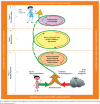A model to facilitate self-management of human immunodeficiency virus in students within a university setting and promoting their mental health
- PMID: 33101714
- PMCID: PMC7564683
- DOI: 10.4102/hsag.v25i0.1069
A model to facilitate self-management of human immunodeficiency virus in students within a university setting and promoting their mental health
Abstract
Background: The introduction of antiretroviral treatment (ART) has resulted in people with HIV living longer. Antiretroviral treatment demands a lifelong commitment from patients not only in terms of adherence to the medication but also in relation to lifestyle changes in general. This poses a challenge to a student living with HIV (SLHIV) who only spends a few years at university before entering the workplace and relocating. It also means that the care, support and treatment received at the university will no longer be available to them as these services are only offered to enrolled students. It is imperative for practitioners at universities to help SLHIV effectively manage their illness.
Aim: The aim of the article is to illustrate the process followed to develop a model that could serve as a frame of reference to facilitate the management of HIV as an integral part of the mental health of SLHIV within a university.
Setting: The model is designed for professional practitioners in university settings who support students living with HIV in managing their illness.
Methods: A theory-generative, qualitative, exploratory, descriptive and contextual study design was utilised. The central concept was derived from the experiences of practitioners and SLHIV by conducting individual interviews using appreciative inquiry. The common themes and categories identified in the interviews served as a basis for the identification of the central concept for the study. The process included the identification, definition and classification of the central concept and essential attributes. The conceptual framework was then described. Measures to ensure trustworthiness were also adhered to in the study and approval for the study was granted (Ethical clearance #2014-071).
Results: The central concept was identified as the 'facilitation of self-management'. It was defined and classified, and these definitions and classifications were used as the basis for the model. Thereafter, the model was described.
Conclusion: The model can be used as a frame of reference to assist SLHIV in effectively managing their illness.
Keywords: HIV; mental health; self-management; students; university.
© 2020. The Authors.
Conflict of interest statement
The authors declare that they have no financial or personal relationships, which may have inappropriately influenced them in writing this article.
Figures
Similar articles
-
Promoting mental health of students living with HIV using appreciative inquiry.Afr J AIDS Res. 2018 Jul;17(2):163-174. doi: 10.2989/16085906.2018.1478312. Afr J AIDS Res. 2018. PMID: 30003845
-
Promoting and supporting self-management for adults living in the community with physical chronic illness: A systematic review of the effectiveness and meaningfulness of the patient-practitioner encounter.JBI Libr Syst Rev. 2009;7(13):492-582. doi: 10.11124/01938924-200907130-00001. JBI Libr Syst Rev. 2009. PMID: 27819974
-
A model for the facilitation of effective management of aggression experienced by Psychiatric Nurses from patients in a psychiatric institution.Curationis. 2016 Nov 30;39(1):e1-e9. doi: 10.4102/curationis.v39i1.1676. Curationis. 2016. PMID: 28155301 Free PMC article.
-
Experiences of HIV-infected adults and healthcare providers with healthcare delivery practices that influence engagement in US primary healthcare settings: a qualitative systematic review.JBI Database System Rev Implement Rep. 2019 Jun;17(6):1154-1228. doi: 10.11124/JBISRIR-2017-003756. JBI Database System Rev Implement Rep. 2019. PMID: 30994499
-
Avoiding and identifying errors in health technology assessment models: qualitative study and methodological review.Health Technol Assess. 2010 May;14(25):iii-iv, ix-xii, 1-107. doi: 10.3310/hta14250. Health Technol Assess. 2010. PMID: 20501062 Review.
References
-
- Babbie E., 2017, The basics of social research, 7th edn., CenGage Learning, Boston, MA.
-
- Bandura A., 1989a, ‘Human agency in social cognitive theory’, American Psychologist 44(9), 1175–1184. - PubMed
-
- Bandura A., 1989b, ‘Social cognitive theory’, in Vasta R. (ed.), Annals of child development, 5th edn., Six theories of child development, vol. 6, pp. 1–60, JAI Press, Greenwich.
-
- Bandura A., 1999, ‘A social cognitive theory of personality’, in Pervin L. & John O. (eds.), Handbook of personality, 2nd edn., pp. 154–196, Guilford Press, New York, NY.
-
- Bandura A. & Adams N., 1977, ‘Analysis of self-efficacy theory of behavioral change’, Cognitive Therapy and Research 1(4), 287–310. 10.1007/BF01663995 - DOI
LinkOut - more resources
Full Text Sources



